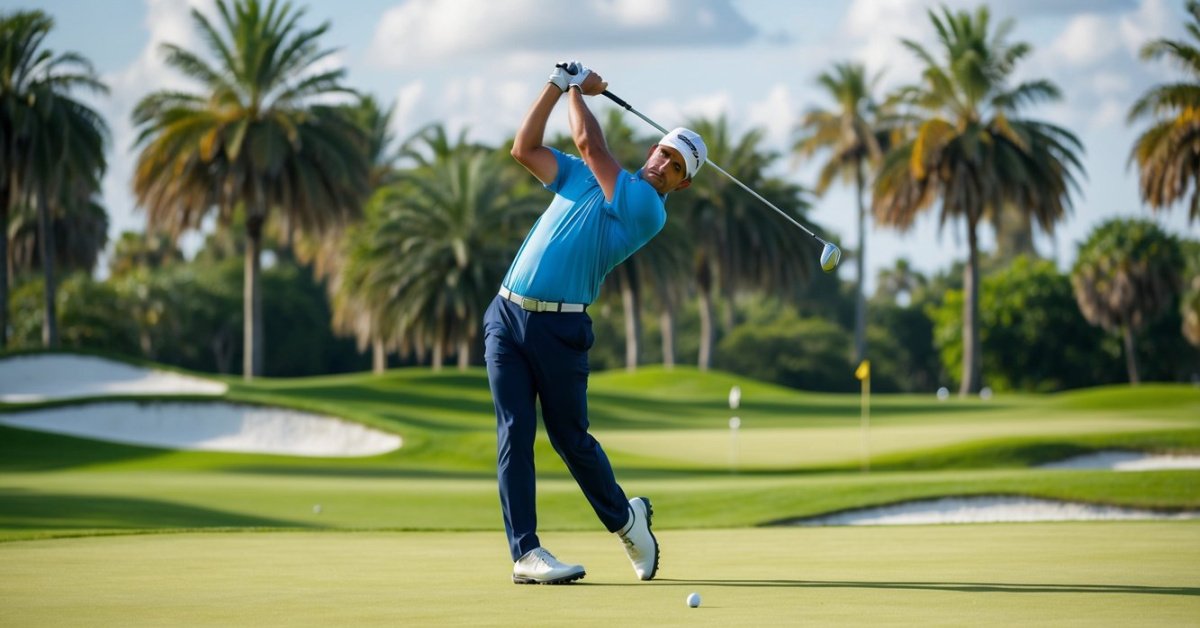Ever wondered why choosing the right golf ball matters? It’s not just about the brand or the price; it’s about the feel and performance. If you’ve ever played with a ball that felt too soft, you know it can be like trying to hit a marshmallow—frustrating, to say the least.

In this article, you’ll discover the unexpected consequences of using a golf ball that’s too soft for your game. From the impact on distance to the way it affects your swing, you’re about to learn why that squishy little sphere might be the secret saboteur of your golf game.
So, if you’re ready to get to the bottom of your golfing woes, stick around. You might just find the key to unlocking a better, more consistent game.
The Importance of Golf Ball Firmness
When you’re out on the course, every element of your equipment can make a significant difference in your performance, and golf ball firmness is no exception. It’s a factor that might not hog the headlines like the latest drivers do, but it’s equally vital to your game.
The Core Counts
At the heart of golf ball firmness is the core. It’s this part of the ball that largely determines its compression and, subsequently, its firmness. Playing with a ball that matches your swing speed isn’t just a recommendation; it’s a game-changer. If you’ve got a powerful swing, a firmer ball will tend to be a better match because it won’t compress as much, leading to better energy transfer and more Distance.
Spin and Control
Firmness is also integral to the spin you can impart on the ball. Generally, a softer ball will spin more, which might help your short game. However, if it’s too soft for your swing, you risk losing control, especially with longer clubs where precision is key. It’s a delicate balance between getting enough spin for command on the greens while maintaining sufficient control from tee to fairway.
Weather and Conditions
Consider this: playing conditions affect ball firmness. Cold weather makes balls firmer, while warm weather can have a softening effect. You’d be wise to account for these factors before hitting the links. Each round may call for a slight adjustment to ensure you’re playing with a ball that complements the conditions you’re facing.
Remember, the key is to find a ball that feels good to you and suits your swing. Don’t be afraid to experiment a bit. Sometimes, the proof of the pudding is in the hitting. Next time you’re at the store or browsing online, give some thought to the compression rating of the balls. It’ll be an educated step towards honing in on the perfect companion for your golfing expeditions.
The Impact on Distance
When you’re out on the course, every yard counts, and the compression rate of your golf ball is a silent partner in your quest for those extra yards. If you’ve chosen a golf ball that’s too soft for your swing, you’re likely sacrificing distance without even knowing it.
« Free Golf Balls Samples 2023: Unlock Your Ultimate Match
How to Put a Golf Ball in a Bottle: Master the Trick in Minutes »
Imagine compressing a marshmallow with a slingshot and expecting it to fly far—it just doesn’t have the necessary firmness to travel long distances. Similarly, a ball that’s too soft absorbs the energy from your swing instead of propelling forward with vigor. When the ball doesn’t have enough compression to match the force of your swing, the energy transfer is less efficient, which results in shorter drives.
Consider this scenario: you’re on the tee with a perfect stance, you’ve practiced your swing, and you’re ready for a long, impressive drive. However, because the ball isn’t firm enough to react to your high swing speed, it deforms too much upon impact and doesn’t rebound as sharply. It’s not just about how hard you hit the ball, but how well the ball can harness and return that energy.
Tests and club fittings repeatedly show that golfers with faster swing speeds typically require firmer golf balls to maximize distance. The sweet spot for those with a high swing speed is a ball that maintains enough integrity on impact to bounce back swiftly and soar.
A softer ball may still offer benefits, like improved feel and control around the greens, but it’s all about trade-offs. You’ve honed your skills to become a low handicapper, and part of that journey is understanding the trade-offs in equipment choices. While evaluating golf balls, you must consider the impact on distance and whether the trade-off in firmness is worth it for your style of play.
Weather conditions, like temperature and altitude, can also play a subtle role in how your ball performs. It’s always smart to keep a range of balls in your arsenal, allowing for adjustments on the fly. Just remember, the core principle remains—match the ball’s firmness to your swing speed to ensure that every drive counts.
Effect on Swing and Control
When you’re out there on the course, every swing counts and the characteristics of your golf ball play a massive part in your game’s outcome. A too soft golf ball can have a surprising effect not just on your distance but also on your swing dynamics and your ability to control the ball.
Let’s put it this way: when you swing with power, you’re looking for a solid response from the ball. However, if the ball is too soft for your swing speed, you’ll find that it deforms too easily upon impact. This means you won’t get that crisp, clean feedback you’re used to, and it might throw off your swing timing. You’ve developed your technique based on certain expectations of performance, and a mismatched ball compressibility can mess with your muscle memory.
Moreover, control is key, especially on your approach shots and when you’re closer to the green. A softer ball might seem like it provides better control due to its ability to stop quickly on the greens. But remember, control isn’t just about sticking your landing; it’s also about predictability in your flight path and spin. If the ball is overly soft, it can lead to excessive spin on your full shots which can hurt your precision.
- With a firmer ball, you’re more likely to get consistent spin rates, leading to predictable flight and roll.
- With a softer ball, the variability in spin due to the increased deformation upon impact can make it harder to hit your intended targets with precision.
Essentially, while a softer golf ball might feel nice around the greens, you’ve got to weigh that against the potential loss in consistency and control on your fuller shots. For you as an accomplished low handicapper, fine margins often dictate the quality of play, and it’s crucial to select a ball that complements your highly-skilled game. Thus, don’t overlook the importance of a golf ball with the appropriate firmness to match your powerful swing. Balancing feel and control will keep your game sharp and avoid unwanted surprises.
Remember, it’s always a game of trade-offs, and what works best for you will depend on your specific swing characteristics, your play style, and the conditions you’re facing on the course.
Misalignment and Shape Distortion
When you’re out on the course, striving to shave strokes off your game, the last thing you want is your equipment betraying you. A too soft golf ball can be a silent saboteur, especially when it comes to misalignment and shape distortion. It’s not just about the feel, but also the geometry of your game. Golf balls designed to be too compliant can deform under the stress of a powerful drive. The impact not only causes the ball to compress, but it can also result in an oval rather than a spherical shape, even if just for a fraction of a second.
This shape distortion might seem negligible, but at the high speeds of a golf swing, even minor variances can cause the ball to start off on an unintended path. When the ball reshapes into its original form, it might move along a flight path that’s not aligned with your target. Your well-practiced swing could be perfectly executed, yet the ball veers off course, leaving you bewildered on the tee box.
Consider the implications of a golf ball that isn’t maintaining its shape through the swing. A less-than-perfect sphere cannot cut through the air as intended. Consequently, aerodynamic efficiency plummets, and with it, your Distance and Accuracy. What you might have intended as a straight shot to the green could undulate its way to a bunker, or worse, the rough.
While on the approach, a softer ball’s advantage of control around the green could backfire if it’s too soft. Slight mis-hits can become magnified, and the usual compensation you’d apply may not correct the misalignment caused by the ball’s deformation. On the green, a putt with a soft ball might feel good off the putter face, but maintaining a true line towards the hole can be more challenging when you’re trying to factor in deformation.
Striking the right balance in ball firmness is key to minimizing these effects. You’ll want a ball that’s firm enough to maintain its shape and alignment off the club face but still offers the level of control and feedback you need. Remember to factor in Swing Speed, Temperature Conditions, and Ball Construction when making your choice.
Conclusion
So you’ve seen how picking a golf ball that’s too soft can mess with your game. It’s clear that while you might gain some control on the greens, you risk losing precious distance and precision on your long shots. Remember, that squishy feel can throw off your swing and send your ball veering off course. To keep your game sharp, aim for a ball that matches your swing speed and the course conditions. That way, you’ll strike that sweet spot between control and power, keeping your shots consistent and your scorecard looking good. Keep experimenting until you find the ball that feels just right in your hands and under your club. After all, the perfect golf ball is out there waiting for you.
Frequently Asked Questions
How does golf ball firmness affect driving distance?
A golf ball’s firmness directly influences driving distance. A ball that is too soft can deform excessively upon impact, thereby reducing the energy transfer from the club to the ball, which results in shorter driving distances. For optimal distance, the ball’s firmness should match the golfer’s swing speed.
Can a soft golf ball affect swing dynamics and control?
Yes, a soft golf ball can impact swing mechanics and control. If the ball deforms too much at impact, it can offer poor feedback, disrupt swing timing, and can cause excessive spin on full shots, hindering precision and control.
Will a softer golf ball provide better control around the greens?
A softer golf ball tends to offer better control around the greens due to its enhanced ability to grip the putting surface and stop quickly, which is beneficial for short game finesse shots.
Why might a too soft golf ball lead to misalignment on drives?
A ball that is too soft can distort into an oval shape under strong impact, resulting in a misaligned path. This deformation can adversely affect the ball’s trajectory, causing a loss in both distance and accuracy.
How should one choose the right golf ball firmness?
Choosing the right golf ball firmness involves considering your swing speed, the ambient temperature, and the ball’s design. Golfers should select a ball that provides a balance between distance and control, matching their personal game style and environmental factors.










